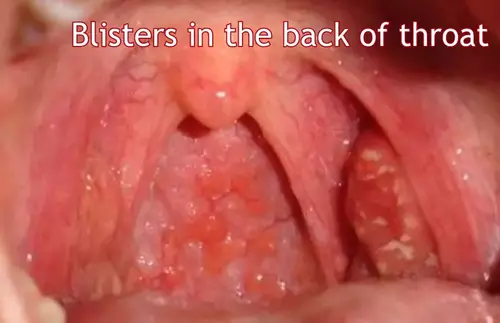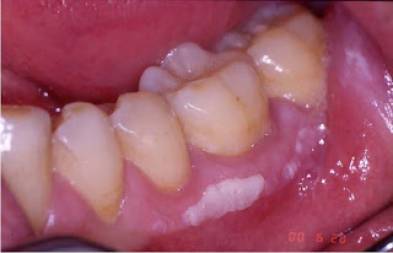Blisters in the back of the throat appear for a number of reasons. In the vast majority of cases, they accompany a sore throat and are often difficult to swallow. Throat blisters are often caused by infection. Let’s look in more detail at why the back of the throat is covered in blisters in this article.
Coxsackievirus
Coxsackievirus is one of the main causes of the unpleasant blisters in the back of your throat. Although children have a much higher risk of getting this virus, it is also possible for adults to get this infection.
Coxsackie is an intestinal virus, or rather a rather large group of as many as 30 enteroviruses.
Most often this virus affects children from about 3 to 10 years old, which is associated with the peculiarities of life style: infrequent hand washing, insufficient hygiene. Ages 4-5 is the most dangerous age for contracting the virus.
See also: Bumps on Tongue and Sore Throat
But infants rarely fear Koksaki: firstly, their immunity protects the mother’s milk, and secondly, their hygiene is usually perfect: they do not play in sandpits and do not take dirty fingers and objects in their mouths for a while.
Infections most often occur in the summer and autumn, especially on holiday by the sea. There are several ways of transmission: airborne, through unwashed hands, dirty raw food, shared utensils.
From the moment of infection to the first signs of the disease can take up to 10 days. It begins rather abruptly, with fever of 102 F or more and lasts for 3-4 days, only then normalizing. The fever is accompanied by weakness, headache and muscle pain.
Very similar to the flu, but this virus adds a specific rash and stool disorders. The rash appears as small blisters on the mucosa of the mouth and throat, on the face around the mouth, on the palms of the hands, feet, between the fingers, and on the buttocks.
Rashes on the mucous membranes of the mouth are accompanied by severe pain, and children refuse to eat or drink. It is important to give your baby something for the pain and watch out for adequate fluid intake.
Do you know how to treat Bad Breath Caused by Post Nasal Drip?
Fluid stools may be a problem several times a day, and vomiting may also occur. Adults may show signs of conjunctivitis.
How to treat? First, you need to call a doctor. Only a pediatrician or therapist (in the case of an adult who fell ill) on the basis of examination and special analysis will be able to make the correct diagnosis.
Going to a hospital is usually not necessary, you can be treated at home. Special antiviral drugs are not required, only symptomatic therapy is needed: for high fever to drink antipyretic, for itchy skin or other skin reactions to the rash may need antiseptic and antihistamine, for intoxication – taking sorbents, for sore throat – antiseptics for the throat.
If there is nothing wrong with the immune system, all manifestations of the virus will pass on their own in a few days without a trace. Antibiotics are not used in the treatment, their prescription is necessary only in the case of accession of bacterial infection.
Good to know: Beginning Signs of Mouth Cancer
Infectious mononucleosis
Infectious mononucleosis is an infectious disease that affects the lymph nodes, oropharynx, spleen, and liver. One of its manifestations (symptoms) is the appearance of blisters, usually on the back of the throat.
The infectious mononucleosis virus is transmitted by aerosol transmission from an infected or already infected person.
The disease begins rather quickly, with a rapid rise in temperature and, in rare cases, can reach 104 F. The child is in a state of fever and due to the weakness of the body and severe sleepiness is mainly in a strictly horizontal position. Lymph nodes become inflamed, the nasopharynx swells and breathing becomes difficult, herpes on the lips and a red rash on the body may occur.
Characteristic syndromes:
- General infectious intoxication: headache, apathy or, on the contrary, agitation, sleep disturbances, general brokenness, joint and muscle pain, general weakness, impaired appetite, reduced ability to work.
- Organ lesions: generalized lymphadenopathy – increase in lymph nodes in two or more non-contiguous areas.
- Tonsillitis (inflammation of pharyngeal and palatine tonsils) with small blisters in the throat.. Is chief in the typical form of the disease.
- Hepatolienal (enlargement of the liver and spleen).
- Changes in hemogram (blood counts)/”mononucleosis” syndrome.
- Exanthema (skin rash). Most often appears when antibiotics are used.
- Disorders of pigment metabolism (jaundice).
- Hospital abstinence (dependence of patients on medical institutions and the formation of their fear of death from the disease).
STDs in Mouth is the serious problem
Pharyngitis
Pharyngitis also manifests itself by the appearance of blisters in the throat, closer to the wall, where the mucosa is more fragile. Pharyngitis is an inflammatory process that forms on the back wall of the larynx and affects the mucous membrane as well as deeper layers, soft palate tissues and lymph nodes. Acute pharyngitis can develop into chronic if the patient does not seek medical attention and self-treats.
The first signs of pharyngitis and its further treatment may vary depending on the stage of the pathology, sex, age and general health of the patient.
The main causes of pharyngitis include:
- Overcooling of the body, eating too cold foods;
- Deformation of the nasal septum;
- strains of microorganisms that cause the development of chlamydia, candidiasis, whooping cough, scarlet fever, measles;
- adenovirus, influenza virus;
- streptococci, staphylococci, pneumococci;
- maxillitis, tonsillitis, cavities, rhinitis;
- nasal breathing difficulties;
- gastrointestinal pathologies: reflux, heartburn, hernia;
- Abuse of bad habits;
- Regular high stress on the vocal cords;
- Contaminated, toxic air;
- Hormonal disorders and endocrine pathologies (diabetes, obesity, hypothyroidism, etc.);
- tonsillectomy, which the patient has had previously;
- Infectious diseases in chronic form;
- weakened immunity.
The first signs of the disease may differ depending on the type of pharyngitis. They are both local and general in nature. But there are common signs that are characteristic of any type of pharyngitis: pain in the throat, bad breath, stuffy ears and difficulty swallowing. If the inflammatory process is active, the body temperature may rise above 38°, which is the way the body fights a foreign infection. Common signs include sweating, poor appetite, weakness, dizziness, fatigue, fever, and chills. Some complain of pain and tinnitus, discomfort when exposed to loud sounds.
During acute catarrhal pharyngitis there is swelling and redness of the mucous membranes of the larynx. Also, red follicles may form on the back wall of the pharynx, accumulate transparent and slightly cloudy mucus. Swelling and reddening of the uvula can be observed.
In purulent form of acute pharyngitis, ulcers with accumulation of purulent masses appear on the surface of the posterior pharyngeal wall.
Read also about Fungus in Mouth
Conclusion
The appearance of blisters on the back of the throat is one of the symptoms of the aforementioned diseases. And, given the fact that some symptoms may coincide and some may not appear in obvious form, the final diagnosis is made only by a doctor after a detailed diagnosis.





